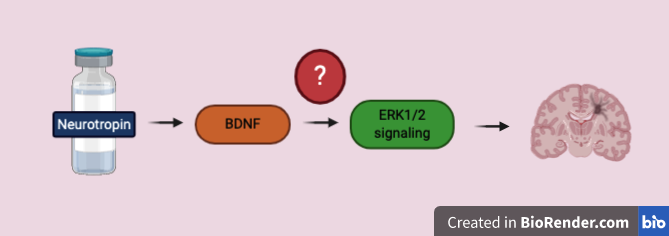69 7.5 Future Directions of Neutropin
Learning Objectives
- Understand Neurotropin’s role in minimizing cognitive impairment and its applications in treating Alzheimer’s Disease
- Identify the limitations of the current research results and discoveries on Neurotropin
- Explore potential research directions to strengthen current findings on Neurotropin
Applications in Alzheimer’s Disease

Studies have shown that Neurotropin treatments in APP/PS1 mice have improved symptoms associated with Alzheimer’s Disease. Amyloid- β deposits and microglial activation in the hippocampus were decreased in mice who had received treatments. Similarly, levels of pro-inflammatory cytokines (IL-1β, IL-6, TNF-α) and the activation of the NF-kB inflammatory pathway was diminished through the increase of BDNF. Furthermore, mice who had received Neurotropin treatments showed less cognitive decline compared to those who had not received treatments. The improvements seen in the APP/PS1 mice demonstrate the potential use of Neurotropin as a drug treatment for Alzheimer’s Disease in humans. Although clinical trials to investigate the effectiveness of the drug in humans is still required before its use, Neurotropin therapy could alleviate debilitating symptoms of the disease by minimizing cognitive decline and may even improve cognitive deficits in patients with Alzheimer’s Disease.
Exploring Other Mechanisms of Action
Although the study identified which physiological factors were affected by Neurotropin treatment, the authors did not investigate the mechanism of action or the pathways by which Neurotropin effects these factors. For instance, the study showed that Neurotropin treatments decreased the NF-kB pathway and also increased BDNF, but were unable to explain the exact mechanism by which this occurred. Future research should explore which intermediate molecules and signals are involved in this pathway to identify the mechanism of action and gain a better understanding of how Neurotropin assumes its therapeutic effect in APP/PS1 mice. The authors also recognized that Neurotopin reduced amyloid- β burden in the APP/PS1, but similarly did not explore the mechanism behind these results. Research from the current literature has established a link between BDNF and ERK1/2 signalling, which is a kinase involved in stimulating amyloid-β protein deposits and the regulation of inflammatory cytokines (Sun, 2017). Elevated levels of ERK1/2 signalling have also been identified in APP/PS1 mice, along with signifiant decreases in BDNF (Long, 2017). These previous findings may indicate a possible mechanism by which Neutrotropin reduced amyloid-β deposits (Figure.8.5.2) in APP/Ps1 mice and should be explored further to understand how Neurotropin minimizes amyloid-β deposits.

Other Potential Uses
The studies have shown that Neurotopin treatments have had successful therapeutic effects on APP/PS1 mice, demonstrating its potential as a good drug candidate for its use for as a treatment option for Alzheimer’s Diseas patients. Although symptoms of the debilitating disease were ameliorated in the mice models, scientists should also explore the extent of Neurotropin’s therapeutic effect. For instance, scientists should investigate whether Neurotropin treatments are more effective for early or late intervention, or if they have positive effects during all stages of Alzheimer’s Disease. In addition, the onset of Alzheimer’s Disease may be caused by varying types of genetic mutations, for example sporadic and familial Alzheimer’s Disease (Dorszewska, 2016). Research should also focus on testing Neurotropin’s efficacy on these different types of Alzheimer’s Disease and determine if the drug should be used in all cases of the disease. Finally, research should be conducted to investigate whether Neurotropin can be used as a preventative drug and whether it may be an option for individuals who are at higher risk of developing Alzheimer’s Disease.
Did you know?
Sporadic Alzheimer’s Disease: caused by a mutation in the APOE gene
Familial Alzheimer’s disease: caused by genetic mutations in APP, PSEN1 and PSEN2 genes
Key Takeaways
- Neurotropin has been shown to inhibit the release of pro-inflammatory cytokines, reduce Amyloid- β deposits, inhibit neuroinflammation, and improve cognitive deficits in APP/PS1 mice
- More research must be done to investigate mechanisms and pathways of Neurotropin
- Large scale clinical trials and investigation on its efficacy for differnt types and stages of Alzheimer’s Disease should be conducted before before its implementing as a treatment
References
Dorszewska, Jolanta, et al. “Molecular basis of familial and sporadic Alzheimer’s disease.” Current Alzheimer Research 13.9 (2016): 952-963.
Sun, Jing, and Guangxian Nan. “The extracellular signal-regulated kinase 1/2 pathway in neurological diseases: A potential therapeutic target.” International journal of molecular medicine 39.6 (2017): 1338-1346.
Tan, Long, et al. “Investigation on the role of BDNF in the benefits of blueberry extracts for the improvement of learning and memory in Alzheimer’s disease mouse model.” Journal of Alzheimer’s Disease 56.2 (2017): 629-640.
Figures 8.5.1-8.5.2 created using BioRender
